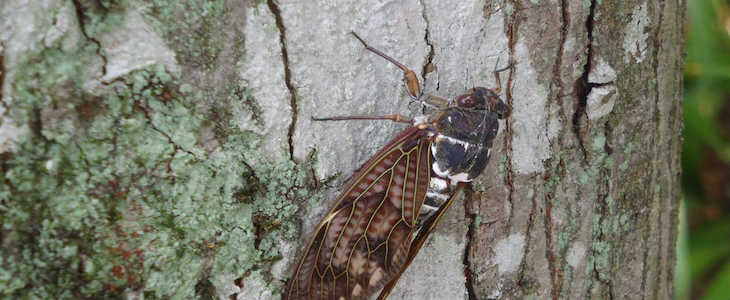
Scary insects of Japan (and how to avoid them!)
Japan – beautiful country known for cherry blossoms in spring and the white top of Mt. Fuji in winter. This country looks so appealing to foreigners with its rich and exotic culture and its healthy food.
But wait! There might be something which can spoil your long-awaited Japan holiday if you are not well prepared.
And I’m not talking about the language barrier or about strange food. Not mentioning the packed trains during rush hour and the heat and humidity in summer…
No, today I want to introduce you to Japan’s awful insects, which might never want to make you come back to Japan once you encountered them. 😉
But don’t worry! There is always a way to fight them (or at least you can try to run away… ;))
- Prepare for summer – Cicadas
Cicadas (in Jap. semi) are the symbol of summertime in Japan. You might have recognized them in movies and anime before and they are also often referred to in literature. Some people like them, some people hate them. However, you will very likely encounter them when you visit Japan in summer.
Before Cicadas become bugs living in the tree, they live as nymphs in the underground and they only leave in summertime to have a short life and finally die after building a nest for their children.
One group of cicadas can generate a sound up to 120 dB, which is very loud. Very very loud. Chances are, they will become your new alarm clock in the morning.
Besides that Cicadas are quite harmless, they won’t attack you, they won’t try to eat you, but they might fall on you when they die during your summer picnic under a tree. Usually those insects die in great numbers, so be prepared for a Cicada shower (which is less pleasant than the Sakura in spring time…)
- The bee killer – the Japanese giant hornet
The Japanese giant hornet (in Jap: Suzumebachi) is a real giant and can measure over 4 cm or 6 cm including the wingspan. That is one big creepy monster.
They look a bit different from the ordinary yellow wasps we know – usually they have quite large yellow heads and yellow and brown stripes on their bellies with a dark brown thorax. You will probably identify them, when you see them. But you might be too close to them, when you can see the stripes on their belly.
Those hornets are venomous. Their stingers can damage the tissues of the victims and attacks their nervous systems. Adding to their evilness, those hornets like to eat European honey bees, you know the cute little honey bees we are facing a shortage of. If you get stung, you should consider seeing a doctor as it is said to be extremely painful and you might actually require hospitalization. How do you avoid them? Well, you can’t do much except run away. Suzumebachis can get really aggressive, which doesn’t necessarily make it easier but chances are you will see and hear them before they will approach you. They are quite loud and easy to spot and I also got the impression that they are not the fastest and best fliers (they would regularly fly against my outside wall which then left me time to close the door/window).
But Japanese make the best out of it and in some local areas they are enjoyed as a fried delicacy.
- Mukade – the Giant Japanese Centipede
This is one of the insects which scares me most. Probably because I know centipedes from Europe – small black crawlers, who will just try to get a away from you as soon as you find them under a stone or a on a pathway.
But in Japan, the country of Godzilla and Mothra, even the Centipedes are not what they are supposed to be.
The Giant Centipede in Japan may grow up to 38 cm and they are poisonous. If it bites you, you may have severe swellings or fever. The bigger they are, the worse the bite. A really good bite even might send you to the doctor, but don’t worry – usually they have an anti-venom to heal your pain. You can also rush to the next Police box, they are equipped with the same anti-venom to help you.
Symbolizing evil, those insects are often depicted in Japanese literature or mythology.
The centipedes appear to be tough critters – quite hard to kill, even after being exposed to boiling water, spray or fire. Some Japanese friend told me, it is best to catch them with two chopsticks and throw them into boiling oil. Now I’m always equipped with my chopsticks and a pot of boiling oil when encountering insects.. 😉
Like Suzumebachi, these monsters with too many legs are also known to be aggressive so you shouldn’t follow your curiosity and get too close for a selfie with it. My first encounter with this beauty? I was just a few meters from my apartment and there it welcomed me home, standing upright on my door step. It. Stood. Upright.
If there is one good thing to say about them, then that they eat cockroaches and other insects. So if you encounter a Giant Centipede in your house you might have no cockroach pest around your area which is… rather nice, huh? And yes, you don’t just encounter them outside but they come into your house. I encountered a baby Mukade in my bathroom on the 3rd floor, just coming out of a hole. 3rd floor!
- Sucking your blood: the Japanese Mountain Leech
No one likes leeches. No one will ever like them!
In Europe we know them living in ponds or other muddy waters, which can be avoided. But the Japanese Mountain Leech doesn’t need water to attack you. He waits for you and your blood on land!
Leeches have been used in medicine for over 2,500 years. They were more popular in earlier times because it was widely thought that most diseases were caused by an excess of blood. However, you might not come to Japan to treat your blood related diseases.
The Japanese Mountain leech can climb trees to fall on you. They also hide in your shoes. Since they are equipped with thousands of small teeth to inject an anti-coagulant and a numbing compound into your blood you might not recognize them first. They will also go through your clothes, so don’t try to wear your knight’s armor for protection. With five pairs of eyes they will find you. And suck the life out of you.
- Huntsman Spider – your harmless but scary nightmare
The Huntsman Spider (in Jap: ashidakagumo) has several names (Giant Scrab Spider, Wood Spider, Cane Spider, Rain, Spider) but what doesn’t change is its size. It is huge. Like the size of a plate huge. It has a hairy body and very long, strong legs. You will find them more in rural areas but of course you might also stumble upon them in a city such as Tokyo. Where will you find them? Well, they normally don’t run around visibly in nature but you will rather encounter them in your own sweet home. When it’s raining, they tend to come inside and hide behind furniture. Another plus point for them and minus point for us; they are incredibly fast. So if you really decide on catching one, you will probably fail.
Huntsman Spider are venomous (but not that much like mukade) but you shouldn’t worry too much because they are more afraid of you than you are of them. It won’t attack you but will more likely just run away from you. And maybe we should try to see behind their hairy, not so beautiful outside. Because they are actually excellent insect exterminators as they feed on cockroaches and other nasty things. And they don’t build webs, so there’s no need to worry about vacuuming the corners. Why not invite one into our home and let them eat all the cockroaches? They won’t bug you (hehe) and you will only notice them when you hear them walking through the apartment. Because they are actually that big that you hear their steps on Tatami or wood.
- Last but not least: Cockroaches
Yes, they are probably the most harmless creatures in this list, when it comes to attacking you or hurting you (the Huntsman Spider gets minus point for its size). But they are disgusting. And gross. Probably only reading the name “Cockroach” creeps you out.
Japanese cockroaches (in Jap: Gokiburi) are very common in Japan. You will encounter them on the long term.
They are unavoidable. Even if you keep your house clean and put your trash out in time, they will find their way inside, as long as there is humidity, hot temperatures and food.
Japanese cockroaches measure from 25 to 35 mm once they reach maturity. Carrying 33 types of bacteria with them you don’t want to have them around you. Prevention helps a lot and Japanese drug stores provide all kinds of roach traps and insect sprays. Cockroaches have great survival skills, so don’t give up, if you feel like you cannot easily fight them.
Find a good overview to Japanese cockroach traps and how to use them on Surviving in Japan.
Good luck with the insect hunt (or running away from them) and enjoy Japan! 🙂
A reminder to let you know that if you are looking for an accommodation in Japan, our portal JapanRoomFinder.com has plenty of apartments and rooms in share houses available all over Japan. Send us an enquiry if you like one of them.
Related Articles
Warning: Undefined array key "sfsi_threadsIcon_order" in /home/veremosglobal/tokyoroomfinder.com/public_html/blog/wp-content/plugins/ultimate-social-media-icons/libs/controllers/sfsi_frontpopUp.php on line 165
Warning: Undefined array key "sfsi_blueskyIcon_order" in /home/veremosglobal/tokyoroomfinder.com/public_html/blog/wp-content/plugins/ultimate-social-media-icons/libs/controllers/sfsi_frontpopUp.php on line 170
Warning: Undefined array key "sfsi_bluesky_display" in /home/veremosglobal/tokyoroomfinder.com/public_html/blog/wp-content/plugins/ultimate-social-media-icons/libs/controllers/sfsi_frontpopUp.php on line 266



